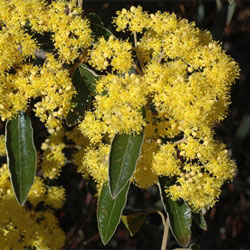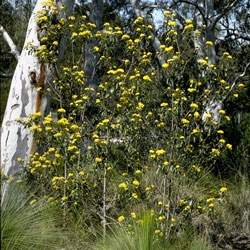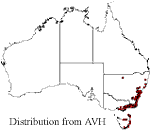Pomaderris intermedia
 |
 |
Pomaderris intermedia Sieber ex DC.
Pomaderris intermedia, belongs in the Rhamnaceae (or Buckthorn) family. This small upright tree or large shrub with an open woody appearance is an outstanding plant for native gardens. On mainland Australia, P. intermedia is found on the open forests on the east coast & ranges of northern New South Wales, through to the woodlands & heaths of southern - central Victoria. In Tasmania the population is much harder to find, with small populations in the northeast, on the east coast and Bass Strait islands.
 Relatively quick growing, P. intermedia grows to approximately 3 m high and spreading to 2 m wide. The young branches, flowering shoots, capsule, leaf stalks and undersurfaces of the leaves are all densely covered in short, stellate (star-shaped) hairs. The leaves are stalked and narrow ovate in shape. The smooth dark green upper foliage differs from the under foliage which has a whitish appearance with scattered long hairs especially along the leaf veins and margins.
Relatively quick growing, P. intermedia grows to approximately 3 m high and spreading to 2 m wide. The young branches, flowering shoots, capsule, leaf stalks and undersurfaces of the leaves are all densely covered in short, stellate (star-shaped) hairs. The leaves are stalked and narrow ovate in shape. The smooth dark green upper foliage differs from the under foliage which has a whitish appearance with scattered long hairs especially along the leaf veins and margins.
The profuse yellow or bright creamy yellow flowers clustered on terminal branches in large flower heads present a striking appearance each September to October. The showy flowers and pleasing dark green foliage are very appealing to native gardeners.
The hairy fruit capsules of P. intermedia are approximately 3 mm in diameter with segments opening inwards. The capsules contain glossy black seeds, which are about 1 mm long. Insects are the most likely pollination vectors of this species, with the fruit maturing around Christmas time, and changing from green to dark brown.
Generally hardy in cultivation, P. intermedia can be propagated from seed or cuttings. To improve germination, pour boiling or hot water over fresh seed and allow the seed to soak in the cooling water for a few hours; alternatively seeds can be microwaved. To further improve results, follow up the heat treatment with smoke (or add soot or charcoal) as this simulates post-fire situations in the natural environment. The little seedlings develop good root systems quite early and can be potted on as soon as the first leaves appear. If propagating from cuttings, short pieces of the firm young growth from the side of the plant dipped into a hormone solution, will strike quickly.
P. intermedia adapts well to cultivation in temperate regions and prefers well-drained acidic soil in a semi-shade through to full sun situation. Hardy against moderate to heavy frosts, it will also tolerate extended dry periods once established. A light application of nitrogen and potassium, or a slow release fertilizer with low phosphorus content, will aid in the development of good foliage growth and flowering.
Chewing insects or borers may be troublesome, and caterpillars may nibble on P. intermedia leaves, but pests are usually not a major problem. P. intermedia is known to be susceptible to infection from the root-rot fungus Phytophthora cinnamomi . It also is known to suffer from leaf fungi.
P. intermedia responds well to light tip pruning after flowering, if done from an early age, as this promotes more dense growth making it a good hedge or screen plant. It is also excellent for planting beneath established trees provided it receives enough sunlight.
Text by Lorraine Owens (2005 Student Botanical Intern)
Derivation of the name: Pomaderris intermediaPomaderris - from the Greek ‘poma' (a covering or lid) and ‘derris' (skin or leather), referring to the calyx (outermost whorl of flower parts), which covers the flowers and fruits. intermedia – or intermediate – referring to the close association with two other Pomaderris species. |
References
Clarke, I. & Lee, H. (2003) Name That Flower: The Identification of Flowering Plants. Melbourne University Press.
Elliot, W.R. & Jones, D.L. (1997) Encyclopaedia of Australian Plants: suitable for cultivation, Vol 7. Lothian Books.
Royal Botanic Gardens Sydney (2000) Flora of New South Wales, Revised Edition, Vol. 1 Sydney UNSW Press.
Walsh, N. G. and Entwisle, T. J., (Eds.) (1997) Flora of Victoria, Vol 4, Dicotyledons – Cornaceae to Asteraceae: Inkata Press, Melbourne.
![An Australian Government Initiative [logo]](/images/austgovt_brown_90px.gif)

